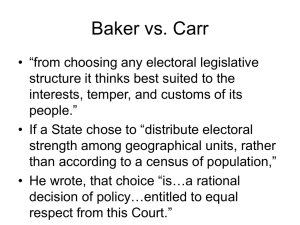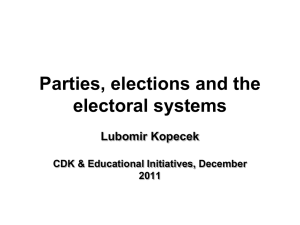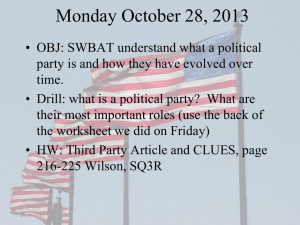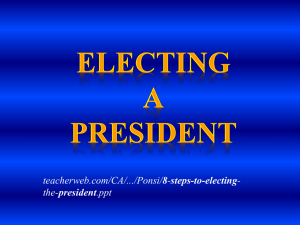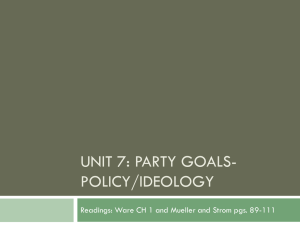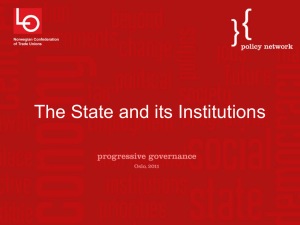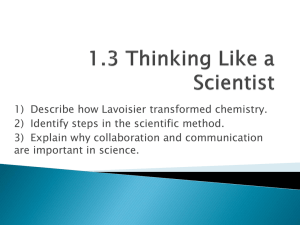Unit 13: Party System Change
advertisement
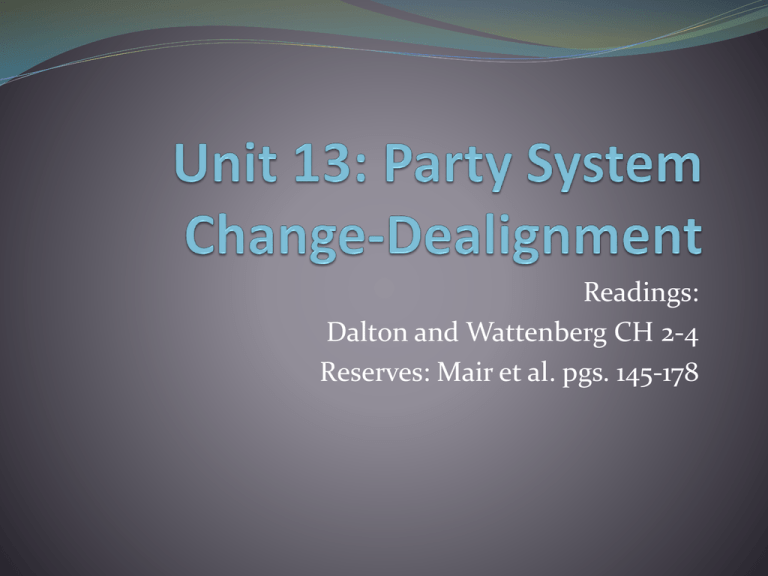
Readings: Dalton and Wattenberg CH 2-4 Reserves: Mair et al. pgs. 145-178 Questions What is dealignment? How is it measured? How would we determine whether or not dealignment was occurring? What risks do parties face as a result of dealignment? Dealignment Dalton 1999; Dalton et al 1999 Partisan ID is fundamental to shaping the relationship between voters and the political system. Focuses on the extent to which voters remain attached to political parties. Notes a decline in partisanship in advanced democracies. Economic development is weakening the relevance of political parties. This weakening undercuts party alignments and can weaken electoral stability. Contend that this weakening is a result of modernization. Also suggest that decline is an ongoing trend, not temporary. Consequences: 1) Political parties functions being eclipsed by other actors 2) Weaker levels of partisan identification 3) Candidate vs. party focused appeals The Case for Dealignment Dalton et al 1999 Hypothesis: If dealignment is occurring due to greater access to education and mass media, we should see a decline in partisanship concentrated in younger age groups. Claims support for this hypothesis. Hypothesis: If greater education and greater access to political information is relevant to dealignment, we should see independent voters who are more, not less involved in their political systems. Claims support for this hypothesis. Consequences of Dealignment: Electoral Participation Wattenberg 1999 Effects of weakening political parties should also be observed in terms of electoral participation . Hypothesis: Dealignment should be associated with a decline in turnout. Focuses on turnout amongst the percentage of the voting age population entitled to vote (not registered voters) who actually cast a valid ballot for the lower house of parliament. Finds a decline in turnout in 17 out of 19 cases. Unclear whether or not this is a short term or a long term trend. Consequences of Dealignment: Electoral Behavior Dalton et al 1999 They look at three factors: 1) Electoral behavior 2) Candidate/party relationships 3) Electoral participation Hypotheses: 1) If dealignment weakens electoral stability, we should see higher levels of electoral volatility. 2) We should also observe more political parties. 3) We should observe increased levels of split ticket voting and divided government. Claim support for all three Consequences of Dealignment: Candidates and Parties Dalton et al 1999 Dealignment shifts politics away from parties and towards individual candidates. The spread of primaries coupled with mass media campaigns facilitate this. Hypothesis: We should expect to see more candidate centered campaigns. Claims support for hypothesis. Argues that the effects are greater in presidential over parliamentary systems. Consequences for Regime? On one hand, voters are still connected to the political process. But they are using alternative methods to obtain political information. Dalton et al 1999 May provide for a more thorough vetting of candidates. Could also provide a platform for extreme parties or demagogues. Decreased turnout can make it easier for parties to win elections; able to limit their appeals to their base. Putnam 1995, 2000 Argues that a decline in turnout indicates a weakness within democracy Wattenberg 1999 Parties are no longer tapping into electorates; problematic. Caveats Small number of data points lead to coefficients that are not significant at conventional levels. If voters are increasingly more sophisticated politically, why would they be drawn to extreme ideologies? If they are open to these appeals, what does this suggest? Disagreement over whether actual disengagement is actually occurring. And whether this is damaging for democracy. The Future of Parties? Realignment may threaten the existence of specific parties but would not endanger political parties as institutions. Dealignment arguably undercuts the centrality of political parties; may strengthen other societal institutions. Is dealignment dangerous for democracy? Research is mixed. Traditional views of the party in the electorate and the party as organization suggest decline. Party identification is declining and other actors are shaping political behavior. Parties remain flexible institutions; unlikely they will wither away Unclear that the party in government is in any danger of replacement. Final Examination Use Mair et al. as case material to address the final examination. No late papers or e-mail copies will be accepted. Plan accordingly. Difficulties accessing reserves does NOT constitute an emergency. Readings available on electronic and hard reserves at Geisel. Due to copyright restrictions we CANNOT send e-mail copies. Please direct all questions regarding reserves to Geisel. Good luck!
